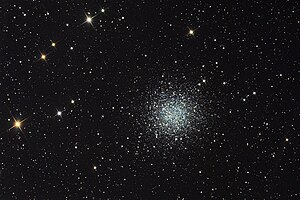

| NGC 5897 | |
|---|---|

The globular cluster NGC 5897 imaged with an amateur telescope.
| |
| Observation data (J2000 epoch) | |
| Class | XI[1] |
| Constellation | Libra |
| Right ascension | 15h17m 24.40s[2] |
| Declination | −21° 00′ 36.4″[2] |
| Distance | 24.1 kly (7.4 kpc)[2] |
| Apparent magnitude (V) | 8.52[2] |
| Physical characteristics | |
| Radius | 6.3' x 6.3'[3] |
| Metallicity | ![{\displaystyle {\begin{smallmatrix}\left[{\ce {Fe}}/{\ce {H}}\right]\end{smallmatrix}}}](https://wikimedia.org/api/rest_v1/media/math/render/svg/4c0821bd80891e071c08e7c7ee8e022baedf522c) = -2.04±0.15[4] dex = -2.04±0.15[4] dex |
| Other designations | GCl 33, C 1514-208[2] |
| See also: Globular cluster, List of globular clusters | |
NGC 5897 is a globular cluster in the constellation Libra. This satellite of the Milky Way, which is quite remote (located about 41,000 light years away), has a diameter of over 170 light years. With its Shapley–Sawyer Concentration Class of XI, it has very low star density even in its center.[3]
The stars of the cluster have only 0.91% of the Sun's metallicity,[5] while the abundance of elements produced by the alpha process is roughly 5 times larger.[4] This means that the cluster formed in a time before the galaxy formed a disk and spiral arms. However, some of the stars are apparently younger, indicating multiple star-forming epochs.[4]
NGC 5897 has a diameter of 12.6 arcminutes and an apparent magnitude of 8.5.
This star cluster–related article is a stub. You can help Wikipedia by expanding it. |